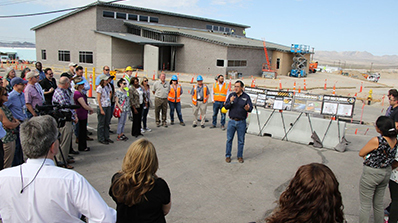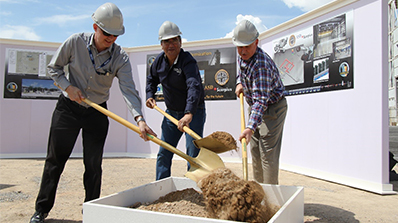The Nevada National Security Site (NNSS) marked significant strides in its modernization plan on July 24, as Nevada Field Office (NFO) Deputy Manager Dave Bowman, Mission Support & Test Services (MSTS) President Mark Martinez and National Nuclear Security Administration (NNSA) Associate Administrator for Safety, Infrastructure and Operations James McConnell broke ground for the U1a Complex’s next phase of infrastructure, slated to support the NNSS for generations to come.
The groundbreaking took place during the Deep Dive, a three-day forum from July 23 to 25 in which NNSA leaders attended a series of master asset plan briefings and reviewed infrastructure investments, maintenance, safety and operations programs.
The U1a Complex, an underground laboratory used to conduct subcritical experiments for the Stockpile Stewardship Program, will undergo extensive structural and utility upgrades. Technological advancements include the installation of Scorpius, which will serve as Advanced Sensor Development for radiographic systems to support Enhanced Capabilities for Subcritical Experiments.
“Nine-hundred sixty feet below us, some of the coolest stuff in all of NNSA is going on right now both in terms of the new things that are being put in, the science and the breakthroughs they represent and the construction and technology that underpins the work,” said McConnell at the U1a Complex. “Those tools are really important, but without people, they’re just machines. The people are really what makes everything go, whether they’re here in Nevada, at our laboratories, plants and sites, or back in Washington, D.C.”
Enhancements include mission-support buildings and an additional shaft, as well as improved water, electrical and communication lines.

“We’re very happy and very proud to be part of an effort to create an environment here on the surface of U1a that is every bit as high quality and worthy of the people as the tools that are being installed below us,” said McConnell. “It is a great time to be in Nevada.”
The investment is part of a larger modernization plan for the NNSS. Mercury, a hub of Site operations, is in the process of transforming its campus through a framework that will consolidate mission support functions. The Site debuted its landmark solar array in 2018, which resulted in the first NNSA Net-Zero-Energy Facility. The solar photovoltaic array currently powers NNSS Fire Station 1, a Leadership in Energy & Environmental Design (LEED) Gold-rated facility. The extra power from the solar array will also provide power for Mercury’s Bldg. 1, set to open in September 2019.
“We have the opportunity to preserve the past and boldly go into the future,” said McConnell. “We have a lot of new work across the NNSA, and a lot of it comes to focus right here in Nevada. This is the place where the old meets the new.”
In addition to the 14,000-square-foot Mercury Bldg. 1, which will house emergency management and information technology office functions for the Site, Mercury modernization plans include future buildings for operations, laboratories and training during the course of the next decade. Water, power and communications investments ensure the facilities will support the NNSS workforce for the next 50 years.
“The intent is to make sure the new campus and new buildings are tied in to a brand new and reliable infrastructure,” said Senior Principal Project Manager Frediee Guevara.
Coordination of the multi-phase NNSS modernization continues to be a mission and morale-driven team effort.
“I’m proud of our procurement people who are able to get the contracts, our safety people who are engaged, our outstanding craft support that is there working behind the scenes the issues that need to be resolved, project management, project engineering—all those things that have come to bear and made this a success for all of us,” said Martinez. “This is the beginning of the future.”
Employee achievements were also celebrated through the several dozen NNSS team members recognized with NNSA Excellence Awards, presented for outstanding accomplishments involving innovation, effectiveness, teamwork, overcoming adversity and enabling future success. NNSS’ award-winning project teams were:
- Device Assembly Facility Argus Project of the Year
- Skill of the Worker Program Team
- Activity Level Work Documents Project Team
- Device Assembly Facility Fire Suppression Lead-in Lines Replacement Portfolio Team
- Operation Restore Power Response Team
- NNSS Support of the Kilowatt Reactor Using Stirling Technology Criticality Experiment Team
- Los Alamos National Laboratory – Support of the Kilowatt Reactor Using Stirling Technology Criticality Experiment Team
- Safety Basis Review Team Project Supporting Transuranic Waste Facility Team
- Mercury Solar Project Team
- Mercury Modernization Area Plan & Cultural Resource Team

